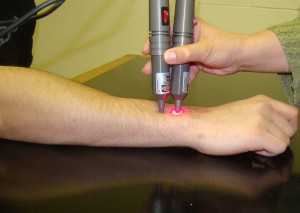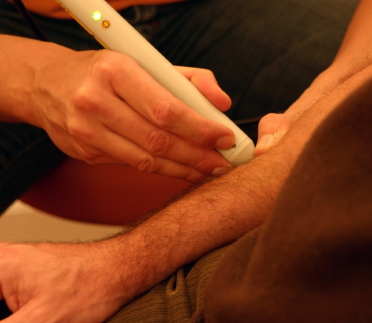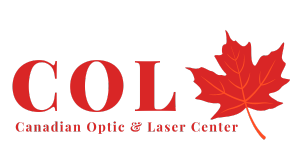
Pain is an unpleasant and horrible sense frequently produced by intense or harmful stimuli, such as hitting a toe, burning a finger, putting alcohol on a cut, and bumping the “funny bone.” The International Association for the Study of Pain’s widely used definition states: “Pain is an unpleasant sensory and emotional experience associated with actual or potential tissue damage, or described in terms of such damage”.
In medicine pain relates to a sensation that hurts. If you feel pain it hurts, you feel discomfort, distress and perhaps agony, depending on the severity of it. Pain can be steady and constant, in which case it may be an ache. It might be a throbbing pain – a pulsating pain. The pain could have a pinching sensation, or a stabbing one.
Low Level Laser Therapy (LLLT) has been clinically recognized as an effective treatment of numerous acute and chronic musculoskeletal pain and disorders, acute and chronic wounds, obesity and smoking addiction. At Canadian Optic and Laser Clinic (COL Clinic) we use only the most advanced and innovated Low Level Laser technology to stimulate healing and promote health.
When it is applied to the skin, Low Level Lasers produce no sensation and do not burn the skin. Because of the low absorption by human skin, Low Level Laser light can penetrate deeply into the tissue. Moreover, ‘laser acupuncture’ has been clinically proven to substantially improve one’s ability to quit smoking, weight loss and fight stress without the need for expensive and harmful medications. Laser Acupuncture is ideal for patients who don’t like acupuncture needles. Studies show it is just as good as acupuncture. In 1998 low level laser therapy was approved by USA FDA as a safe and without side effects method. In 2002 LLLT was approved for pain controlling of carpal tunnel syndrome and temporary pain relief of upper limbs.
What is LLLT Low Level Laser Therapy?
Low Level Laser Therapy classically called cold laser or LLLT is non-invasive and is a non-medical technique. LLLT is a very good method to aid tissue repair, pain controlling, including nerve regeneration and is excellent for bone formation. For example, a typical cold laser can speed up a non-union fracture in the hand or foot. Laser therapy can also be used as a safe alternative to acupuncture when applied to acupuncture points. This is good for needle phobic patients (those with a fear of needles).

How Does Laser Therapy work?
Low level cold laser is pain free; it works from visible to infra-red spectrum of light. It penetrates up to 5-7cm into the muscles, tendons, and ligaments of the body without any effect on superficial layers and with no pain, so it can easily get to deep painful and damaged tissue inside the body very easily. Once the treatment site is targeted the laser light stimulates the cell within muscles, tendons or ligaments where it has a bio-simulative (healing) effect. It accelerates the cell division increasing healing at twice the normal rate. Low Level Laser Therapy promotes improved cellular repair and stimulates the immune, lymphatic, and vascular systems.
Who Is a Good Candidate for Low-Level Laser Therapy?
If you suffered an injury, undertaken orthopedic surgery, or hurt from arthritis or other painful conditions, you can be a candidate for low-level laser therapy. The low-level laser not only speeds the healing process but affects the overall feature of the repaired tissue. Muscle, tendon and ligament injuries require increased collagen production for successful healing and low-level lasers stimulate this function. Light also increases vascular growth and dilation for improved circulation in joints that may have limited movement. The biochemical effect of the low-level laser boosts body’s production of endorphins. Low-level laser therapy is another great way to treat the source of pain, thereby making it less likely that you will need additional pain reducing medication. LLLT can be used over metal implants and pins in the joints of the body, unlike ultra sound or electrical medical equipment.
What Can Laser Therapy Treat?
- Sports and Dance Injuries – Laser therapy is ideal in accelerating tissue healing method used for sprained and strained muscles, ligaments and tendon, including tendonitis and repetitive strain injuries (RSI).
- Arthritis – Laser therapy has been proven to help ease the pain of arthritis.
- Nerve Regeneration- Laser therapy can also be employed to regenerate nerves and it is a very good treatment for Bells-Palsy (paralysis of one side of the face).
- Speeds Up Broken Bone Formation – Laser therapy has been successfully used to accelerate none union fractures of the hand and foot in weeks.
- Pain Relief – In muscles, joints, and nerves, Whiplash, Plantar fasciitis, Trauma, Arthritis, Migraine headaches, Lower back pain, Repetitive stress injuries (RSI), Carpal tunnel syndrome (CTS), Tendonitis, Fibromyalgia / myofascial pain, Rotator cuff injury, Sprains and strains, Post-operative pain, Knee, foot, ankle pain, Tennis elbow, Golfer’s elbow, TMJ inflammation and pain, Soft tissue injuries, Swelling, Post-operative wounds, burns, pressure sores
How Long Does a Treatment Take?
Treatments are typically 15 minutes to 30 minutes depending on the condition being treated. The general process is the probe containing laser diode(s) being held in place or moved gently over the treatment area.

How Many Treatments Are Required?
The average number of treatments required by patients is about 8, but it varies from 3 to 20 treatments depending on the severity of the injury.
Are There Any Side Effects?
Unlike most pharmaceutical solutions and other therapeutic options, laser therapy is non-toxic and non-invasive. No significant adverse effects have been noted in over 1 million individual treatments. The only general precaution is the use of special filtering glasses when a class 3B laser is in use.
What Are Post Care Recommendations?
There is no specific post care; just relax and rest during the therapeutic sessions and give enough time to damaged tissue until it heals. Consumption of vitamin E (400 IU) and A (2000-3000 IU or 700-900 mg) daily can increases the bio-stimulative effect of LLLT.
* The results may vary from person to person.
